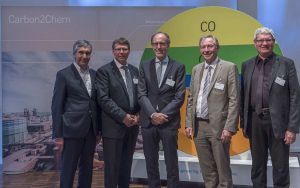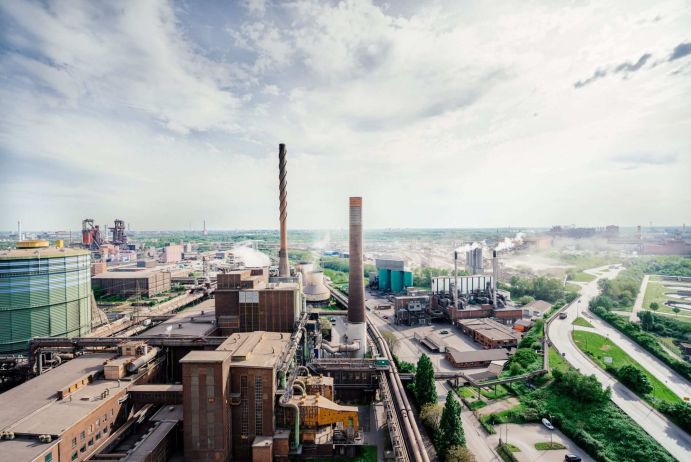Carbon2Chem
The Carbon2Chem project explores how smelter gases from steel production can be used to create valuable primary products for fuels, plastics, or fertilizers. The Carbon2Chem approach aims to use 20 million tons of the German steel industry's annual CO2 emissions in this way. The second phase of Carbon2Chem will validate the developed processes for large-scale implementation thus laying the foundation for low-emission operation. To reach this goal, the Ministry of Science and Education is funding the project with a further 84 million euros until 2025.
Since 2016, numerous industrial companies have been working with the Max Planck and Fraunhofer societies and universities to develop a solution for the conversion of waste gases from blast furnaces into precursors for fuels, plastics or fertilizers. The project partner produce the hydrogen required for this purpose from green electricity with electrolysers. In the second phase of the project, the focus will be on transferring the concept to other CO2 sources such as waste incineration and cement plants.
Since its launch in March 2016, Carbon2Chem has already made great progress. In September 2018 the joint technical center was inaugurated at thyssenkrupp in Duisburg. It is the only site in the world where the individual processes of the concept are brought together in practice and tested under industrial conditions with real exhaust gases. In addition, in March 2019 the project's own laboratory at Fraunhofer UMSICHT in Oberhausen was inaugurated. Making use of 500 square meters of laboratory space and 30 office workstations, the partner consortium is working together on processes for gas purification and the production of methanol and higher alcohols. In the second phase of Carbon2Chem, the technical processes are now to be further validated and scaled up for industrialization starting in 2025.
Coordinators thyssenkrupp AG, MPI-CEC and FhG-UMSICHT manage Carbon2Chem and navigate internal and external communication. The technological starting point of the concept is the composition, purification and treatment of exhaust gases at the thyssenkrupp site in Duisburg. Based on this, three project subgroups are developingdifferent economically viable product paths: methanol, higher alcohols and polymers. A separate sub-project aims to transfer the Carbon2Chem technology to various CO2 point sources such as cement, power and waste incineration plants.
An overlapping sub-project is joining the individual building blocks into an optimized, coherent system network with the help of extensive simulations and modeling. The results include studies of the economic efficiency and ecological impact.
An important precursor for successful implementation is the future supply of hydrogen to the steel plant. To explore this precondition, import chains for renewable energy carriers are modeled and investigated experimentally.

The hydrogen required for this solution is produced by the companies using surplus electricity from renewable energy sources. A new pilot plant, where researchers test their laboratory results with real smelter gases, was commissioned in September 2018 in Duisburg.
Within the next ten years, the Carbon2Chem research project will develop a sustainable value chain linking various sectors so that climate protection will promote innovations on a cross-sector basis. It is not only the steel industry that will benefit from Carbon2Chem, as chemical companies will be able to exploit a new, clean source of raw materials.
At the same time, Carbon2Chem will answer two central questions of the energy transition. How can electrical energy be stored and how can the electrical grid be stabilized?
The research project is divided into the following seven subprojects:
- L0: Project management and system integration (coordination: thyssenkrupp)
- L1: Water electrolysis and grid stability (coordination: thyssenkrupp)
- L2: Sustainable methanol production (coordination: AkzoNobel)
- L3: Gas purification and catalysis (coordination: Linde)
- L4: Higher alcohols and polyalcohols (coordination: Evonik)
- L5: Polymers (coordination: Covestro)
- L6: Oxymethylene ethers (coordination: BASF)
Through Carbon2Chem, the partners from science and industry are building a bridge from basic research to the market. The German Federal Ministry of Education and Research funded the project with more than 60 million euros in the first phase. A further 84 million euros are being provided by the BMBF for the second phase. The partners involved plan to invest more than 100 million euros by 2025, and have earmarked more than one billion euros for commercial implementation.
About the project
Title: Carbon2Chem
Duration: 15 March 2016 - 31 May 2020 (1st funding period)
1 June 2020 - 31 July 2025 (2nd funding period)
BMBF-Funding: 144 million Euros
Project partners: AkzoNobel, BASF, Clariant, Covestro, Evonik, Fraunhofer-Institut für Solare Energiesysteme (ISE), Fraunhofer-Institut für Umwelt-, Sicherheits- und Energietechnik (UMSICHT), Karlsruher Institut für Technologie (KIT), Linde, Max-Planck-Institut für Chemische Energiekonversion, Max-Planck-Institut für Kohlenforschung, RWTH Aachen, Ruhr-Universität Bochum (RUB), Siemens, Technische Universität Kaiserslautern, thyssenkrupp, Volkswagen, Zentrum für Brennstoffzellentechnik (ZBT)
Climate protection in the industry: Carbon2Chem focusses on the same topic area as the BMBF-feasibility study MACOR, which examines the SALCOS-concept in detail. SALCOS is a further alternative how CO2 emissions at steel plants can be further reduced. Contrary to Carbon2Chem, SALCOS will not utilize the blast furnace gases for chemical products, but will modify the initial process of steel making by integrating "green" hydrogen. As a consequence, SALCOS belongs to the CDA (Carbon Direct Avoidance) instruments while Carbon2Chem is part of the CCU (Carbon Capture and Usage/Utilisation) actions.
Last updated on




